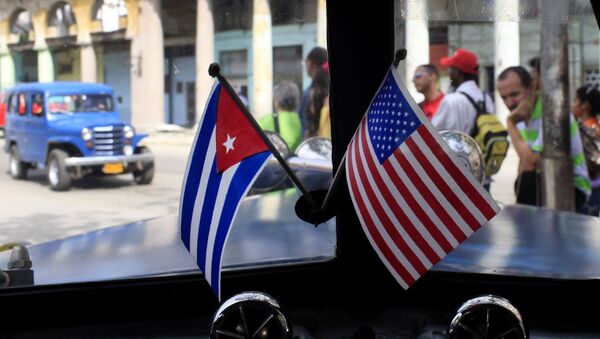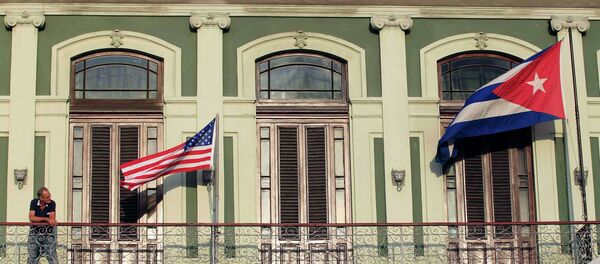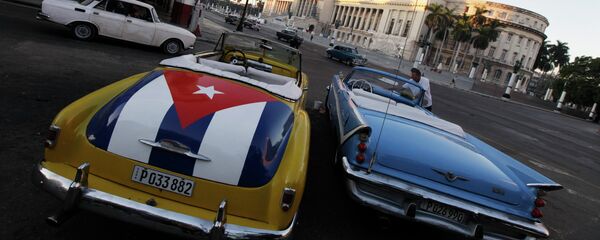MOSCOW (Sputnik) — April 10 marks the start of the 7th Summit of the Americas in Panama, where US President Barack Obama will meet with his Cuban counterpart Raul Castro.
US-Cuban relations have been strained for many years, only starting to improve recently.
Before the Cuban revolution of 1959, the entire national economy was closely linked with the US economy.
In the seven years before the revolution, US companies made $800 million in profits in Cuba.
Cuba maintained close military and political cooperation with the United States. Guantanamo Bay Naval Base (GTMO) that was established in eastern Cuba in 1903 continues to function to this day.
The US media, educational, ideological and cultural influence was unprecedentedly large in Cuba.
Other sectors were sacrificed in favor of sugar production for the US market. Cuba therefore started importing vitally important foodstuffs, consumer goods, and raw materials.
Cuban-US relations began to deteriorate almost immediately after the government of Fidel Castro took over. In May 1959, Cuba launched revolutionary transformations. Private farms were expropriated, and sugar plants and the US-owned telephone and electrical engineering companies were nationalized.
Then, in September 1960, Cuba nationalized the branches of all North American banks. The revolutionary authorities turned down all US proposals on settling property relations. In response, Washington banned crude oil exports to Cuba and stopped purchasing Cuban sugar.
On January 2, 1961, the United States severed diplomatic relations with Cuba.
In January 1962, Washington persuaded the Organization of American States to expel Cuba. At the insistence of the United States, all Latin American countries, except Mexico, severed diplomatic and economic relations with Cuba. A US military intervention in Cuba was openly contemplated.
Tensions in bilateral relations peaked during the Cuban missile crisis of 1962, when the USSR deployed its nuclear-headed missiles on the island and aimed them at the United States.
In February 1963, the United States passed the Cuban Assets Control Regulations. Various bans served as the main US leverage over Cuba. In 1966, US citizens were prohibited from visiting Cuba.
In the 1960s and the 1970s, the government of Fidel Castro followed a foreign policy course that confronted the United States and its allies.
In the late 1970s, mutual travel restrictions were eased, and Cuban emigrants were allowed to visit their homeland.
On May 30, 1977, the United States and Cuba agreed to exchange diplomatic representatives and to establish the United States Interests Section in Havana and the Cuban Interests Section in Washington, DC.
The Cuban-US relations continued to improve throughout the 1990s.
The Cuban government condemned the 9/11 terrorist attacks in New York City and Washington D.C. Numerous US legislators and public activists started visiting Cuba.
In early 2002, Fidel Castro received a massive delegation of US legislators and businessmen, who announced after the meeting that they were ready to advocate for anti-embargo bills.
Although the administration of President George W. Bush did not lift the embargo, the farmer lobby at the US Congress railroaded a bill allowing the delivery of agricultural produce to Cuba.
President Barack Obama repeatedly spoke about a new approach toward relations with Cuba, and said Washington could lift the sanctions against Havana.
On December 10, 2013, Cuban leader Raul Castro met with President Barack Obama at the funeral of Nelson Mandela in South Africa, and the two leaders shook hands. This was the first face-to-face meeting between Cuban and US leaders since the Cuban revolution of 1959.
In June 2014, the Uruguay-based publication Busqueda quoted official sources as saying that President Jose Mujica of Uruguay had handed a message from President Barack Obama to Cuban leader Raul Castro. Castro voiced his readiness for rapprochement with the United States only if Washington did not try to impose its own opinion on Havana.
On December 17, 2014, Havana released American citizen Alan Phillip Gross who had been imprisoned since 2009. Gross and another American citizen were exchanged for three Cubans serving prison time in the United States for alleged espionage activities.
On the same day, the US and Cuban Presidents spoke with each other on the phone for 60 minutes, the first such conversation since the Cuban revolution. They discussed upcoming changes in bilateral relations and prisoner exchanges, as well as cooperation prospects in such areas as the Ebola virus, counter-terrorist operations, and efforts to combat smuggling.
On December 17, 2014, President Obama announced the official normalization of relations with Cuba, including the restoration of diplomatic relations, the lifting of financial, trade and visa restrictions, and the forthcoming decision to exclude Cuba from the list of sponsors of terrorism.
President Obama also said he was ready to negotiate with Congress for the lifting of the over-50-year US embargo against Cuba. He acknowledged that the economic blockade policy did not correspond with US interests and had almost no effect.
Since December 2014, when both countries announced an improvement in their relations, Washington and Havana have hosted several rounds of talks on various issues.
Havana is voicing its own terms for subsequent dialogue. Above all, the United States needs to lift the longstanding economic embargo, which has resulted in $100 billion worth of losses for Cuba. This amount may be even greater, considering dollar-to-gold depreciation rates. The return of GTMO under Cuban jurisdiction is another mandatory precondition.







